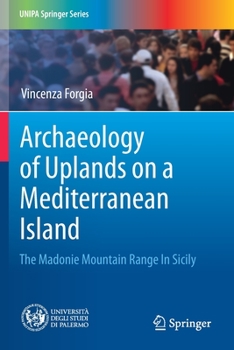Archaeology of Uplands on a Mediterranean Island: The Madonie Mountain Range in Sicily
Select Format
Select Condition 
Book Overview
1 Introduction
1.1 The Madonie mountains: a geographical introduction
1.2 History of previous archaeological research
1.2.1 The researches by Francesco Min? Palumbo and Marquis Antoine De Gregorio
1.2.2 Discovering the antiquity of the human presence on the Madonie Mounts: the "Chiusilla" and "Fico" Caves
1.2.3 Re-discovering the antiquity of the human presence on the Madonie Mountains in the "Vecchiuzzo" Cave
1.2.4 Re-discovering the antiquity of the human presence on the Madonie Mountains in the "Abisso del Vento" a new inspection
1.3 The archeology of the Madonie in the museums
1.3.1 Museo Min? Palumbo in Castelbuono
1.3.2 Museo Civico Baldassare Romano in Termini Imerese
1.3.3 Museo Antonino Collisani in Petralia Sottana
1.4 The paleoecological framework1.4.1 The coastal ecozones
1.4.2 The mountainous environments
References
2. Methods
2.1. Probabilistic Survey: the sampling design
2.1.1 Stratified samples
2.1.2 Sample areas: a brief description of physical features and natural environment
2.1.3 The systematic survey within sample areas
2.1.4 Prospection by focused inspections: a "targeted survey"
2.2 The archival research
2.2.1 Historic Cartography
2.2.2 Current cartography
2.2.3 Toponymy
2.3 GPS and GIS
2.3.1 GPS and mobile GIS
2.3.2 GIS2.4 The paleoenvironmental reconstruction
2.5 The excavation of a key site - Vallone Inferno
References
3 The Madonie: highlands in Sicily
3.1 Results of the field survey within sample areas
3.2 The Archaeological map
3.2.1 SAMPLE AREA 1 - Carbonara environment (ROE IV)
3.2.1.1 UT 24 - Battaglietta - open air settlement3.2.1.2 UT 7 - Monte Ferro - lithic scatter
3.2.1.3 UT 8 - Monte Ferro - sporadic
3.2.1.4 UT 25 - Zottafonda fences - open air site and coal places
3.2.2 SAMPLE AREA 2 - Monte dei Cervi (ROE IV)
3.2.2.1 UT 9 - Piano Battaglia - Sporadic finds
3.2.2.2 UT 6 - Monte dei Cervi - Sporadic finds
3.2.2.3 UT 43 - Cozzo Cerasa - lithic scatter next rock shelter
3.2.2.4 UT 39 - Case di Mastro Peppino - open air site
3.2.2.5 UT 30 - Valle Nipitalva - Lithic scatter
3.2.2.6 UT 108 - Valle Nipitalva - Lithic scatter
3.2.2.7 UT 110 - Valle Nipitalva - Lithic scatter
3.2.2.8 UT 104 P.lla Colla, Quacella - open air site
3.2.3 SAMPLE AREA 3 - Isnello valley (ROE II)
3.2.3.1 UT 10 - C.da e casa Mongerrati - potsherd scatter area
3.2.3.2 UT 1 and 2 - C.da San Nicola - potsherds scatter area
3.2.3.3 UT 4 - C.da San Nicola - open air settlement
3.2.3.4 UT 14 - Abisso del Vento at Cozzo Balatelli - ritual and funerary cave contexts
3.2.3.5 UT 15 - C.da Farchio - sporadic lithic scatter
3.2.3.6 UT 12 - Monte Balatelli - Potsherds dispersion area
3.2.3.7 UT 72 - C.da Gallefina - Burial cave
3.2.3.8 UT 16 - C.da Aculeia - natural cave and sporadic lithics
3.2.3.9 UT 11 and 54 - C.da San Giovanni - Potsherds scatter area
3.2.4 SAMPLE AREA 4 - Imera river valley - right bank (ROE II)
3.2.4.1 UT 47 - Vallone Inferno - open air site (rock shelter)
3.2.4.2 UT 53 - C.da Cava - Potsherds scatter area
3.2.4.3 UT 56 - Borgo Eras C - open air site
3.2.4.4 UT 57 - Borgo Eras C - open air site
3.2.4.5 UT 51 - 52 - C.da Cava - sporadic and potsherds scatter area
3.2.4.6 UT 58 - Acqua Cannata - settlement
3.2.4.7 UT 59 - Acqua Cannata - Sporadic finds3.2.4.8 UT 60 - Timpa dei Filici - Rock shelter
3.2.4.9 UT 61 - Portella di Mare - Settlement
3.2.4.10 UT 64 - Portella di Mare - Settlement
3.2.4.11 UT 66 - Il Boschetto - Potsherds scattered area
3.2.5 SAMPLE AREA 5 - S. Venera (ROE III)
3.2.5.1 UT 101 - C.da





